Organizational Behaviour and Leadership
VerifiedAdded on 2020/01/15
|16
|4249
|188
AI Summary
This assignment delves into various aspects of organizational behaviour, focusing on leadership styles. It examines their influence on corporate social responsibility, exploring how different leadership approaches shape organizational ethics and societal impact. The analysis extends to conflict management styles, investigating how cultural differences influence conflict resolution across diverse teams. Additionally, the assignment analyzes motivational tools and theories, evaluating their effectiveness in driving organizational success.
Contribute Materials
Your contribution can guide someone’s learning journey. Share your
documents today.
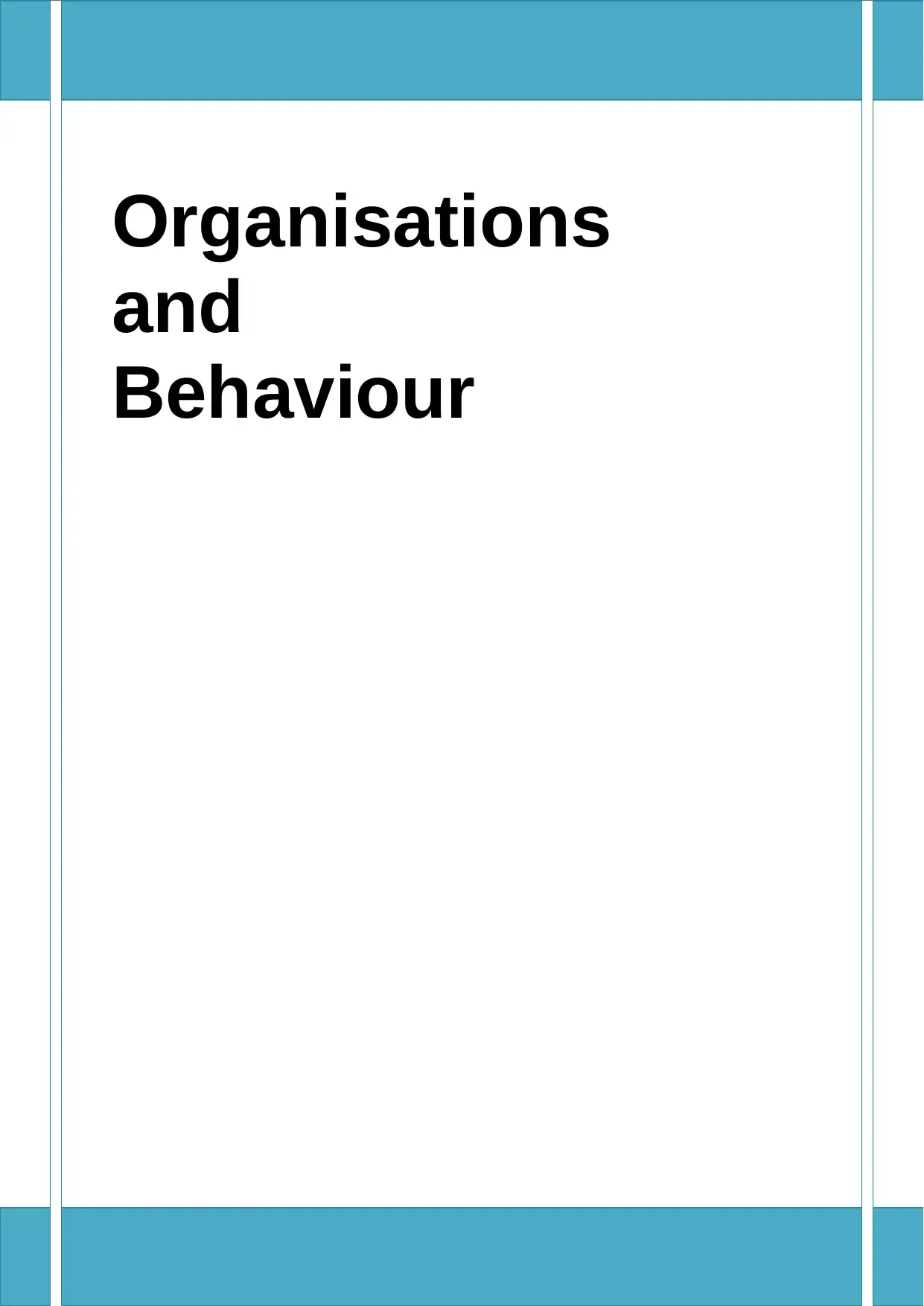
Organisations
and
Behaviour
1
and
Behaviour
1
Secure Best Marks with AI Grader
Need help grading? Try our AI Grader for instant feedback on your assignments.
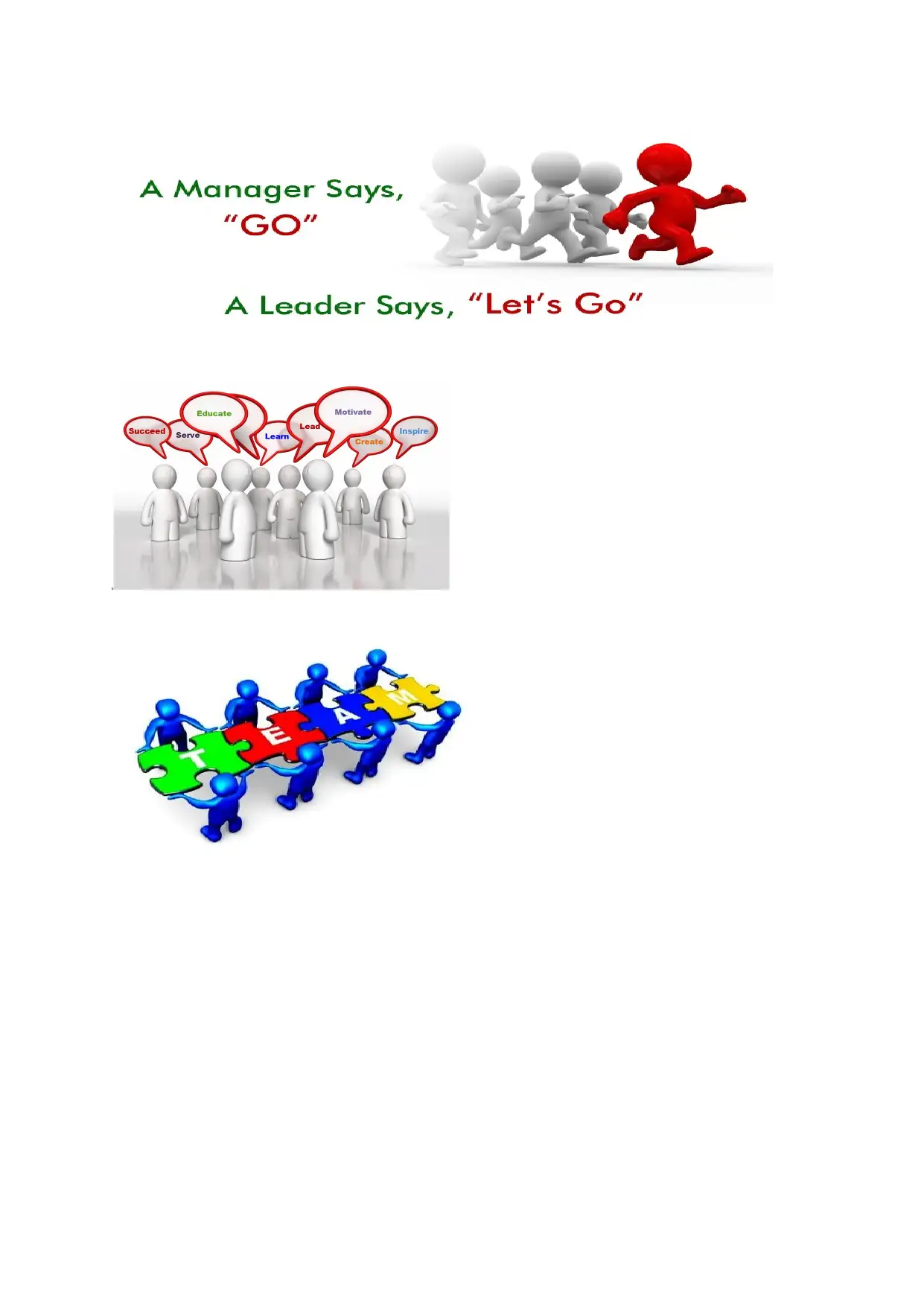
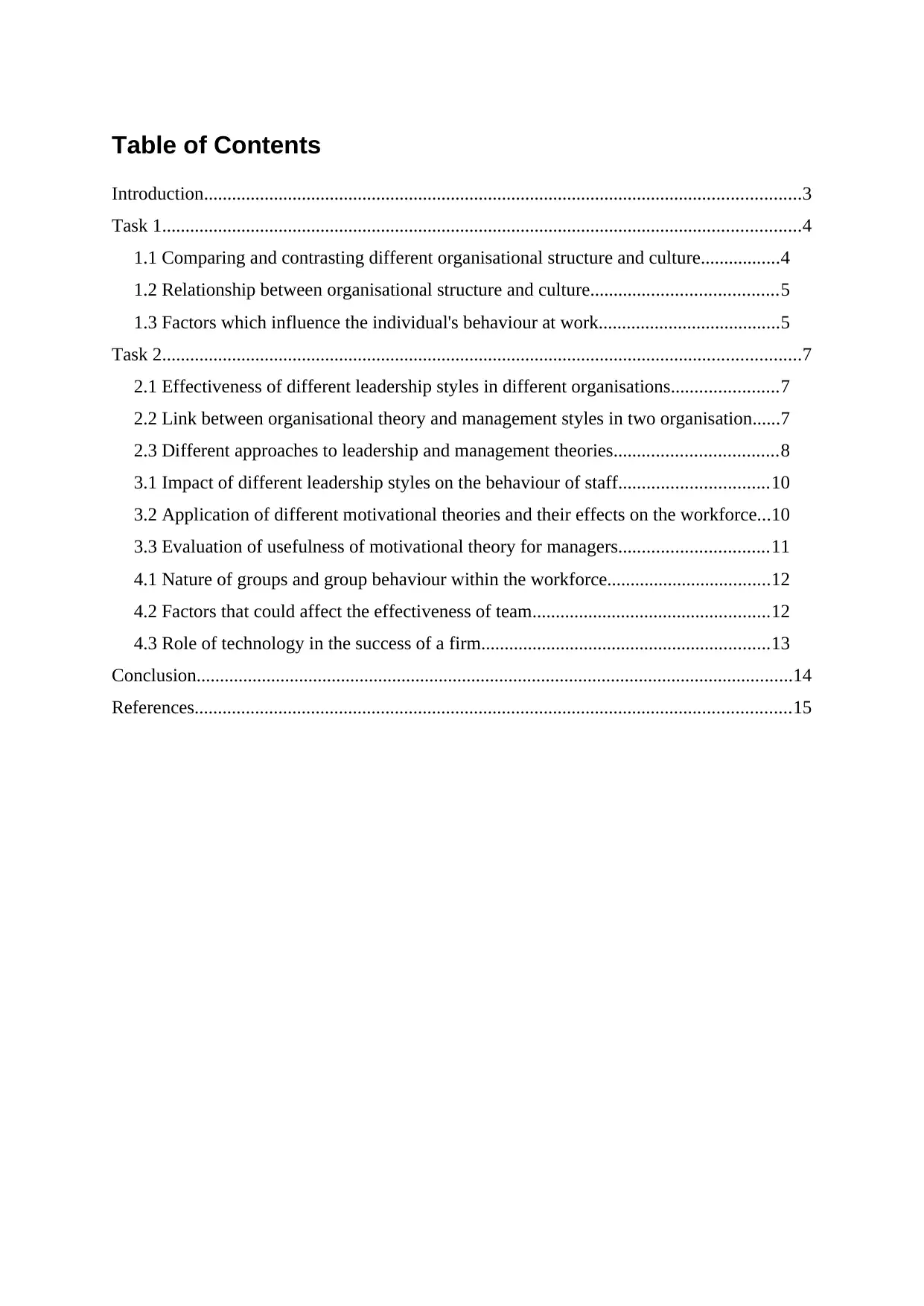
Table of Contents
Introduction................................................................................................................................3
Task 1.........................................................................................................................................4
1.1 Comparing and contrasting different organisational structure and culture.................4
1.2 Relationship between organisational structure and culture........................................5
1.3 Factors which influence the individual's behaviour at work.......................................5
Task 2.........................................................................................................................................7
2.1 Effectiveness of different leadership styles in different organisations.......................7
2.2 Link between organisational theory and management styles in two organisation......7
2.3 Different approaches to leadership and management theories...................................8
3.1 Impact of different leadership styles on the behaviour of staff................................10
3.2 Application of different motivational theories and their effects on the workforce...10
3.3 Evaluation of usefulness of motivational theory for managers................................11
4.1 Nature of groups and group behaviour within the workforce...................................12
4.2 Factors that could affect the effectiveness of team...................................................12
4.3 Role of technology in the success of a firm..............................................................13
Conclusion................................................................................................................................14
References................................................................................................................................15
Introduction................................................................................................................................3
Task 1.........................................................................................................................................4
1.1 Comparing and contrasting different organisational structure and culture.................4
1.2 Relationship between organisational structure and culture........................................5
1.3 Factors which influence the individual's behaviour at work.......................................5
Task 2.........................................................................................................................................7
2.1 Effectiveness of different leadership styles in different organisations.......................7
2.2 Link between organisational theory and management styles in two organisation......7
2.3 Different approaches to leadership and management theories...................................8
3.1 Impact of different leadership styles on the behaviour of staff................................10
3.2 Application of different motivational theories and their effects on the workforce...10
3.3 Evaluation of usefulness of motivational theory for managers................................11
4.1 Nature of groups and group behaviour within the workforce...................................12
4.2 Factors that could affect the effectiveness of team...................................................12
4.3 Role of technology in the success of a firm..............................................................13
Conclusion................................................................................................................................14
References................................................................................................................................15
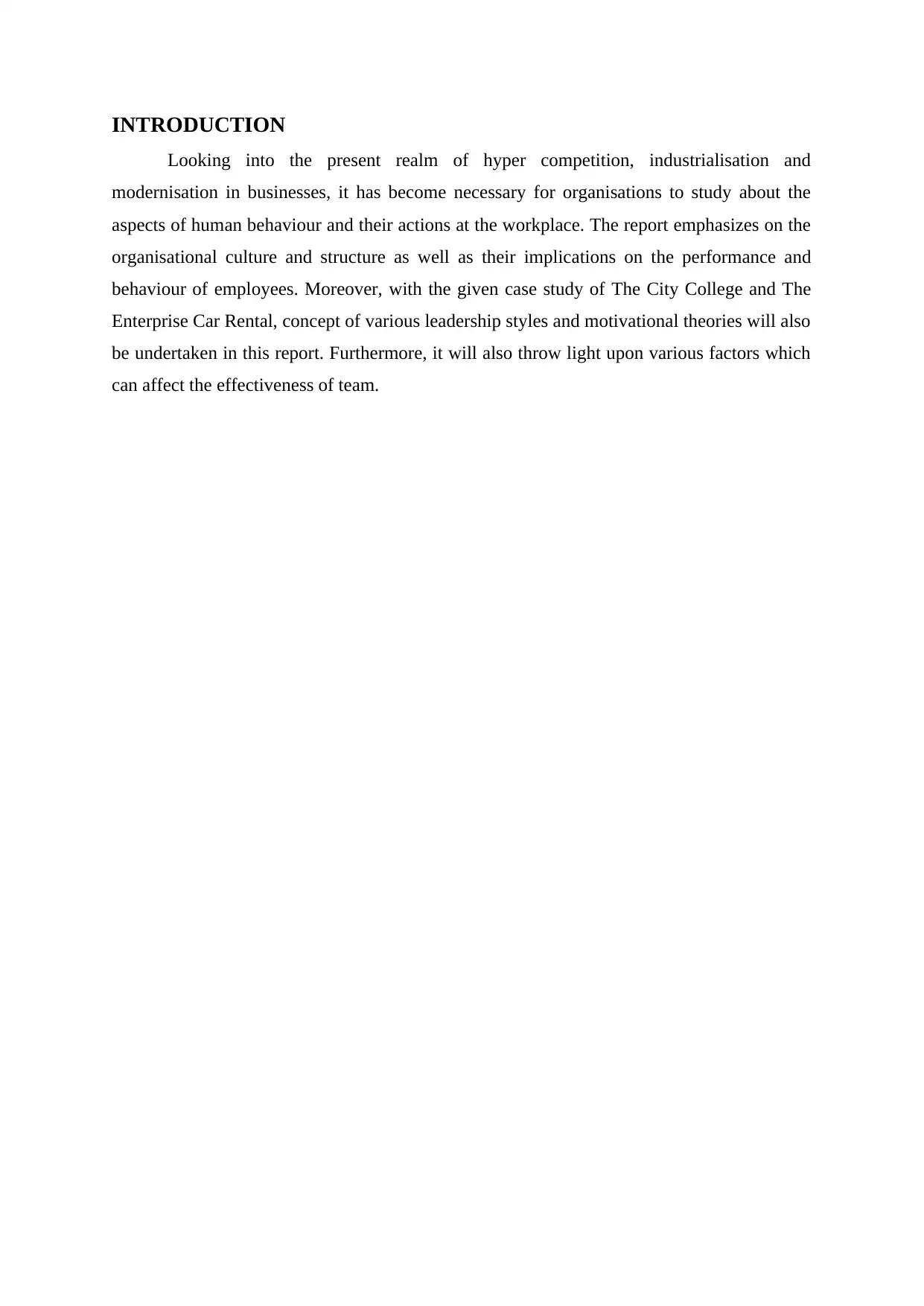
INTRODUCTION
Looking into the present realm of hyper competition, industrialisation and
modernisation in businesses, it has become necessary for organisations to study about the
aspects of human behaviour and their actions at the workplace. The report emphasizes on the
organisational culture and structure as well as their implications on the performance and
behaviour of employees. Moreover, with the given case study of The City College and The
Enterprise Car Rental, concept of various leadership styles and motivational theories will also
be undertaken in this report. Furthermore, it will also throw light upon various factors which
can affect the effectiveness of team.
Looking into the present realm of hyper competition, industrialisation and
modernisation in businesses, it has become necessary for organisations to study about the
aspects of human behaviour and their actions at the workplace. The report emphasizes on the
organisational culture and structure as well as their implications on the performance and
behaviour of employees. Moreover, with the given case study of The City College and The
Enterprise Car Rental, concept of various leadership styles and motivational theories will also
be undertaken in this report. Furthermore, it will also throw light upon various factors which
can affect the effectiveness of team.
Secure Best Marks with AI Grader
Need help grading? Try our AI Grader for instant feedback on your assignments.
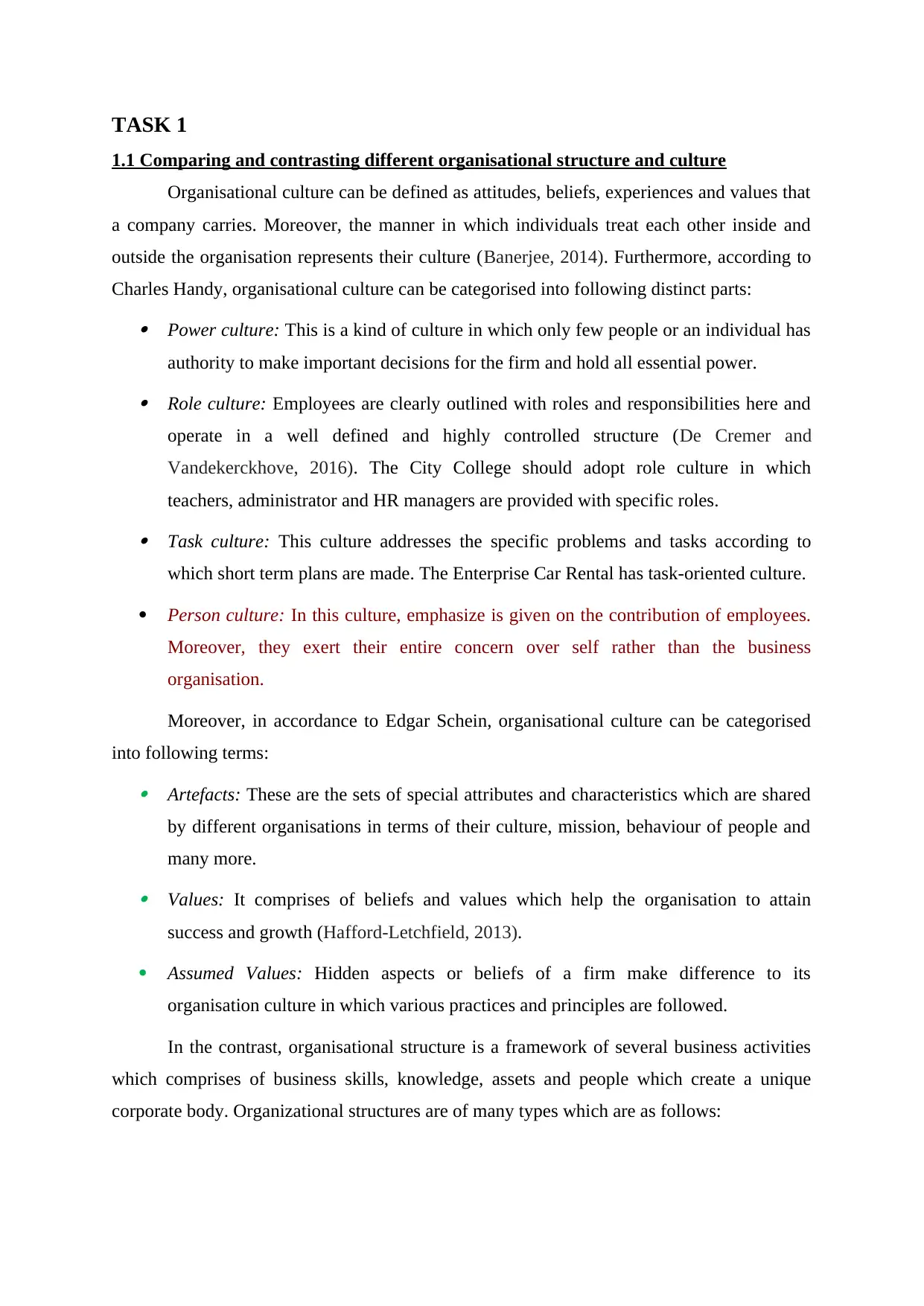
TASK 1
1.1 Comparing and contrasting different organisational structure and culture
Organisational culture can be defined as attitudes, beliefs, experiences and values that
a company carries. Moreover, the manner in which individuals treat each other inside and
outside the organisation represents their culture (Banerjee, 2014). Furthermore, according to
Charles Handy, organisational culture can be categorised into following distinct parts: Power culture: This is a kind of culture in which only few people or an individual has
authority to make important decisions for the firm and hold all essential power. Role culture: Employees are clearly outlined with roles and responsibilities here and
operate in a well defined and highly controlled structure (De Cremer and
Vandekerckhove, 2016). The City College should adopt role culture in which
teachers, administrator and HR managers are provided with specific roles. Task culture: This culture addresses the specific problems and tasks according to
which short term plans are made. The Enterprise Car Rental has task-oriented culture.
Person culture: In this culture, emphasize is given on the contribution of employees.
Moreover, they exert their entire concern over self rather than the business
organisation.
Moreover, in accordance to Edgar Schein, organisational culture can be categorised
into following terms: Artefacts: These are the sets of special attributes and characteristics which are shared
by different organisations in terms of their culture, mission, behaviour of people and
many more. Values: It comprises of beliefs and values which help the organisation to attain
success and growth (Hafford-Letchfield, 2013).
Assumed Values: Hidden aspects or beliefs of a firm make difference to its
organisation culture in which various practices and principles are followed.
In the contrast, organisational structure is a framework of several business activities
which comprises of business skills, knowledge, assets and people which create a unique
corporate body. Organizational structures are of many types which are as follows:
1.1 Comparing and contrasting different organisational structure and culture
Organisational culture can be defined as attitudes, beliefs, experiences and values that
a company carries. Moreover, the manner in which individuals treat each other inside and
outside the organisation represents their culture (Banerjee, 2014). Furthermore, according to
Charles Handy, organisational culture can be categorised into following distinct parts: Power culture: This is a kind of culture in which only few people or an individual has
authority to make important decisions for the firm and hold all essential power. Role culture: Employees are clearly outlined with roles and responsibilities here and
operate in a well defined and highly controlled structure (De Cremer and
Vandekerckhove, 2016). The City College should adopt role culture in which
teachers, administrator and HR managers are provided with specific roles. Task culture: This culture addresses the specific problems and tasks according to
which short term plans are made. The Enterprise Car Rental has task-oriented culture.
Person culture: In this culture, emphasize is given on the contribution of employees.
Moreover, they exert their entire concern over self rather than the business
organisation.
Moreover, in accordance to Edgar Schein, organisational culture can be categorised
into following terms: Artefacts: These are the sets of special attributes and characteristics which are shared
by different organisations in terms of their culture, mission, behaviour of people and
many more. Values: It comprises of beliefs and values which help the organisation to attain
success and growth (Hafford-Letchfield, 2013).
Assumed Values: Hidden aspects or beliefs of a firm make difference to its
organisation culture in which various practices and principles are followed.
In the contrast, organisational structure is a framework of several business activities
which comprises of business skills, knowledge, assets and people which create a unique
corporate body. Organizational structures are of many types which are as follows:
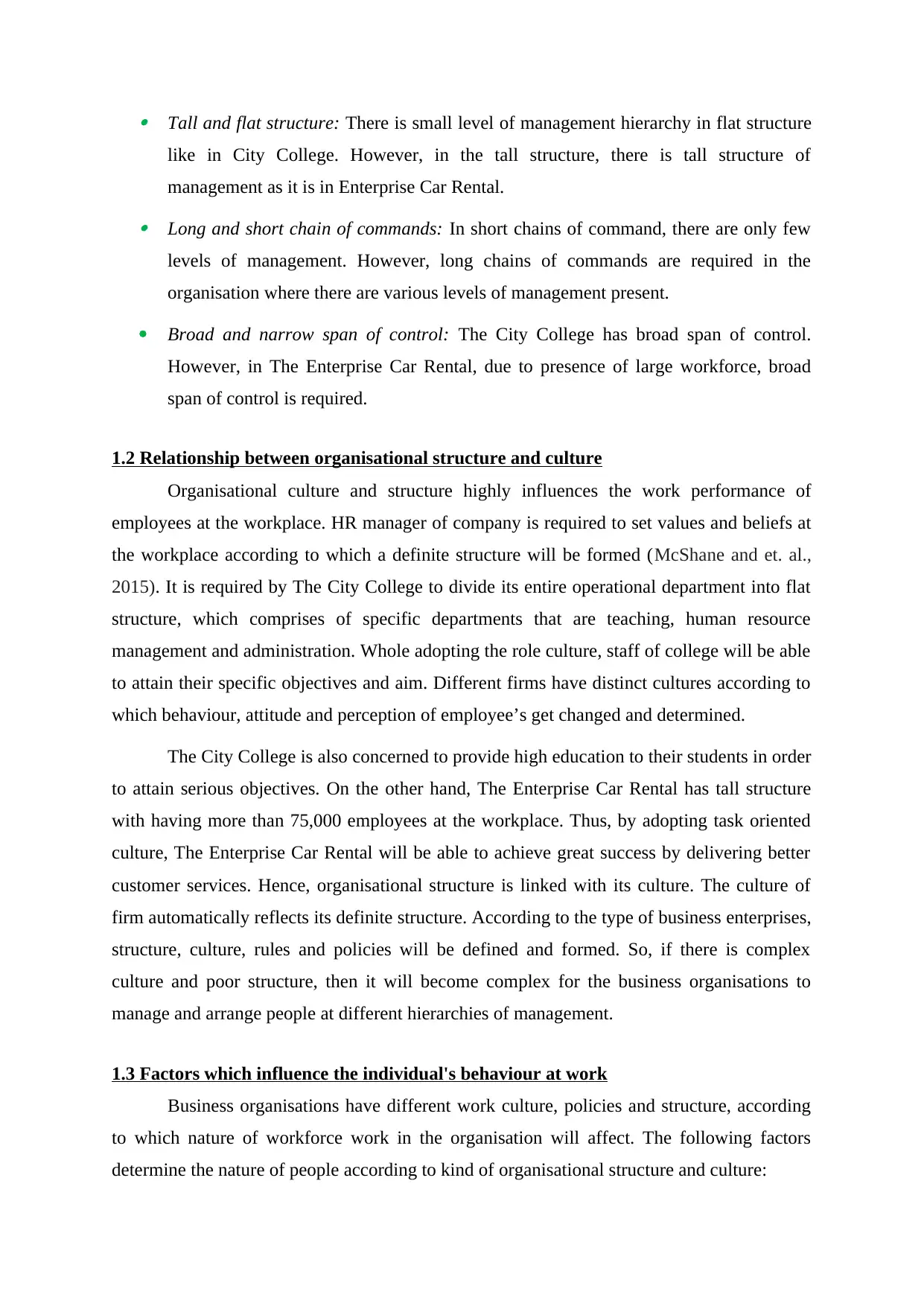
Tall and flat structure: There is small level of management hierarchy in flat structure
like in City College. However, in the tall structure, there is tall structure of
management as it is in Enterprise Car Rental. Long and short chain of commands: In short chains of command, there are only few
levels of management. However, long chains of commands are required in the
organisation where there are various levels of management present.
Broad and narrow span of control: The City College has broad span of control.
However, in The Enterprise Car Rental, due to presence of large workforce, broad
span of control is required.
1.2 Relationship between organisational structure and culture
Organisational culture and structure highly influences the work performance of
employees at the workplace. HR manager of company is required to set values and beliefs at
the workplace according to which a definite structure will be formed (McShane and et. al.,
2015). It is required by The City College to divide its entire operational department into flat
structure, which comprises of specific departments that are teaching, human resource
management and administration. Whole adopting the role culture, staff of college will be able
to attain their specific objectives and aim. Different firms have distinct cultures according to
which behaviour, attitude and perception of employee’s get changed and determined.
The City College is also concerned to provide high education to their students in order
to attain serious objectives. On the other hand, The Enterprise Car Rental has tall structure
with having more than 75,000 employees at the workplace. Thus, by adopting task oriented
culture, The Enterprise Car Rental will be able to achieve great success by delivering better
customer services. Hence, organisational structure is linked with its culture. The culture of
firm automatically reflects its definite structure. According to the type of business enterprises,
structure, culture, rules and policies will be defined and formed. So, if there is complex
culture and poor structure, then it will become complex for the business organisations to
manage and arrange people at different hierarchies of management.
1.3 Factors which influence the individual's behaviour at work
Business organisations have different work culture, policies and structure, according
to which nature of workforce work in the organisation will affect. The following factors
determine the nature of people according to kind of organisational structure and culture:
like in City College. However, in the tall structure, there is tall structure of
management as it is in Enterprise Car Rental. Long and short chain of commands: In short chains of command, there are only few
levels of management. However, long chains of commands are required in the
organisation where there are various levels of management present.
Broad and narrow span of control: The City College has broad span of control.
However, in The Enterprise Car Rental, due to presence of large workforce, broad
span of control is required.
1.2 Relationship between organisational structure and culture
Organisational culture and structure highly influences the work performance of
employees at the workplace. HR manager of company is required to set values and beliefs at
the workplace according to which a definite structure will be formed (McShane and et. al.,
2015). It is required by The City College to divide its entire operational department into flat
structure, which comprises of specific departments that are teaching, human resource
management and administration. Whole adopting the role culture, staff of college will be able
to attain their specific objectives and aim. Different firms have distinct cultures according to
which behaviour, attitude and perception of employee’s get changed and determined.
The City College is also concerned to provide high education to their students in order
to attain serious objectives. On the other hand, The Enterprise Car Rental has tall structure
with having more than 75,000 employees at the workplace. Thus, by adopting task oriented
culture, The Enterprise Car Rental will be able to achieve great success by delivering better
customer services. Hence, organisational structure is linked with its culture. The culture of
firm automatically reflects its definite structure. According to the type of business enterprises,
structure, culture, rules and policies will be defined and formed. So, if there is complex
culture and poor structure, then it will become complex for the business organisations to
manage and arrange people at different hierarchies of management.
1.3 Factors which influence the individual's behaviour at work
Business organisations have different work culture, policies and structure, according
to which nature of workforce work in the organisation will affect. The following factors
determine the nature of people according to kind of organisational structure and culture:
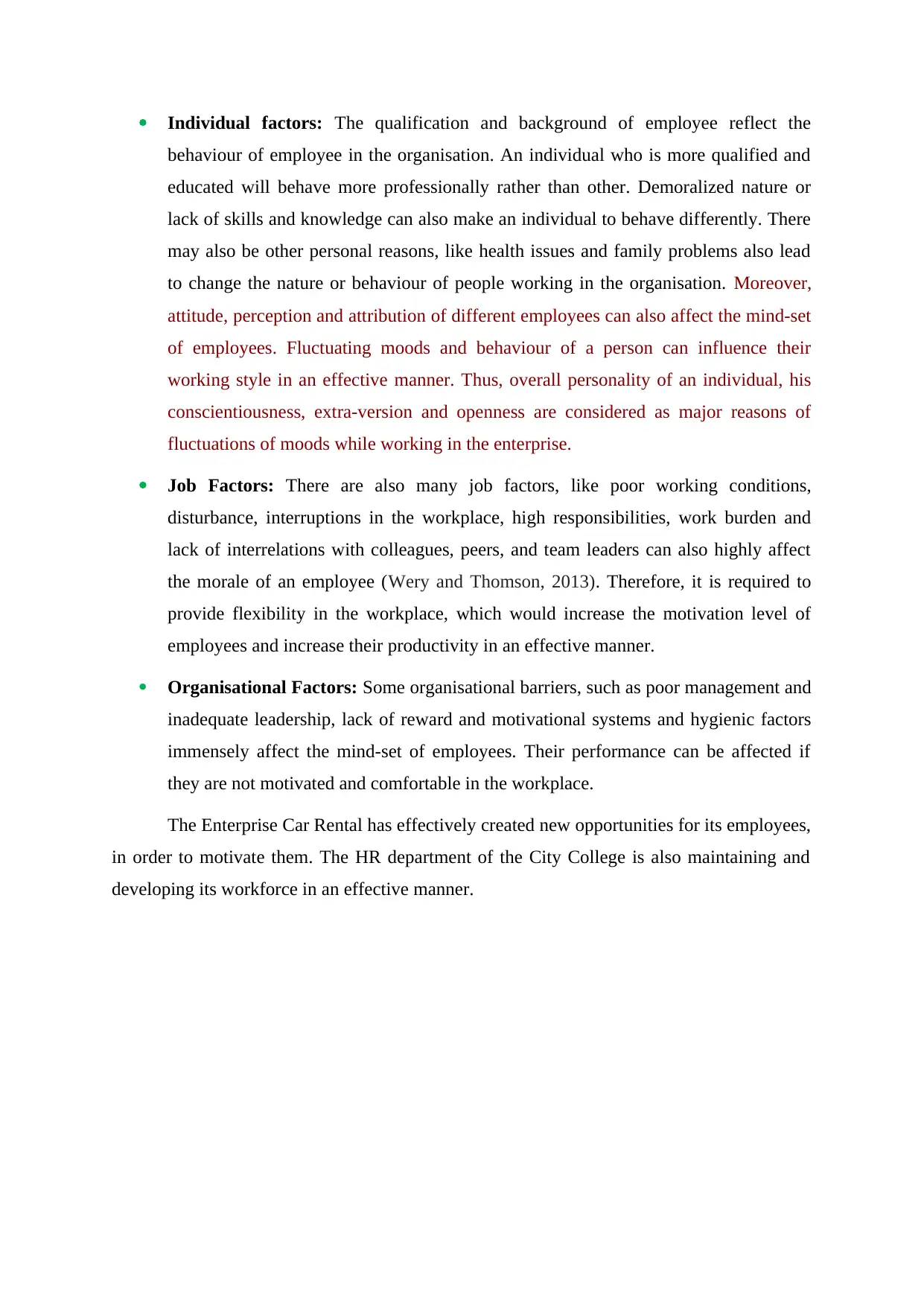
Individual factors: The qualification and background of employee reflect the
behaviour of employee in the organisation. An individual who is more qualified and
educated will behave more professionally rather than other. Demoralized nature or
lack of skills and knowledge can also make an individual to behave differently. There
may also be other personal reasons, like health issues and family problems also lead
to change the nature or behaviour of people working in the organisation. Moreover,
attitude, perception and attribution of different employees can also affect the mind-set
of employees. Fluctuating moods and behaviour of a person can influence their
working style in an effective manner. Thus, overall personality of an individual, his
conscientiousness, extra-version and openness are considered as major reasons of
fluctuations of moods while working in the enterprise.
Job Factors: There are also many job factors, like poor working conditions,
disturbance, interruptions in the workplace, high responsibilities, work burden and
lack of interrelations with colleagues, peers, and team leaders can also highly affect
the morale of an employee (Wery and Thomson, 2013). Therefore, it is required to
provide flexibility in the workplace, which would increase the motivation level of
employees and increase their productivity in an effective manner.
Organisational Factors: Some organisational barriers, such as poor management and
inadequate leadership, lack of reward and motivational systems and hygienic factors
immensely affect the mind-set of employees. Their performance can be affected if
they are not motivated and comfortable in the workplace.
The Enterprise Car Rental has effectively created new opportunities for its employees,
in order to motivate them. The HR department of the City College is also maintaining and
developing its workforce in an effective manner.
behaviour of employee in the organisation. An individual who is more qualified and
educated will behave more professionally rather than other. Demoralized nature or
lack of skills and knowledge can also make an individual to behave differently. There
may also be other personal reasons, like health issues and family problems also lead
to change the nature or behaviour of people working in the organisation. Moreover,
attitude, perception and attribution of different employees can also affect the mind-set
of employees. Fluctuating moods and behaviour of a person can influence their
working style in an effective manner. Thus, overall personality of an individual, his
conscientiousness, extra-version and openness are considered as major reasons of
fluctuations of moods while working in the enterprise.
Job Factors: There are also many job factors, like poor working conditions,
disturbance, interruptions in the workplace, high responsibilities, work burden and
lack of interrelations with colleagues, peers, and team leaders can also highly affect
the morale of an employee (Wery and Thomson, 2013). Therefore, it is required to
provide flexibility in the workplace, which would increase the motivation level of
employees and increase their productivity in an effective manner.
Organisational Factors: Some organisational barriers, such as poor management and
inadequate leadership, lack of reward and motivational systems and hygienic factors
immensely affect the mind-set of employees. Their performance can be affected if
they are not motivated and comfortable in the workplace.
The Enterprise Car Rental has effectively created new opportunities for its employees,
in order to motivate them. The HR department of the City College is also maintaining and
developing its workforce in an effective manner.
Paraphrase This Document
Need a fresh take? Get an instant paraphrase of this document with our AI Paraphraser
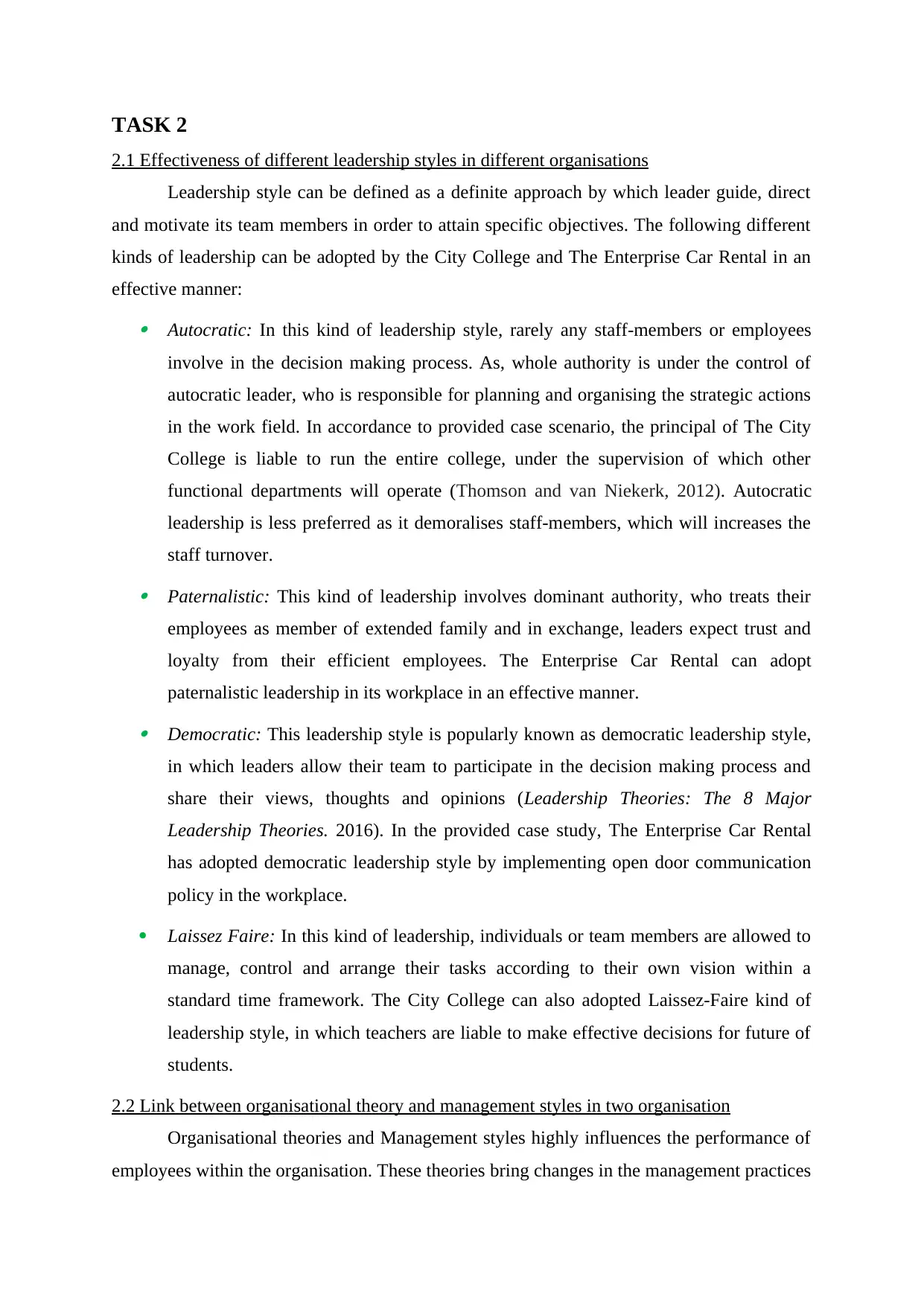
TASK 2
2.1 Effectiveness of different leadership styles in different organisations
Leadership style can be defined as a definite approach by which leader guide, direct
and motivate its team members in order to attain specific objectives. The following different
kinds of leadership can be adopted by the City College and The Enterprise Car Rental in an
effective manner: Autocratic: In this kind of leadership style, rarely any staff-members or employees
involve in the decision making process. As, whole authority is under the control of
autocratic leader, who is responsible for planning and organising the strategic actions
in the work field. In accordance to provided case scenario, the principal of The City
College is liable to run the entire college, under the supervision of which other
functional departments will operate (Thomson and van Niekerk, 2012). Autocratic
leadership is less preferred as it demoralises staff-members, which will increases the
staff turnover. Paternalistic: This kind of leadership involves dominant authority, who treats their
employees as member of extended family and in exchange, leaders expect trust and
loyalty from their efficient employees. The Enterprise Car Rental can adopt
paternalistic leadership in its workplace in an effective manner. Democratic: This leadership style is popularly known as democratic leadership style,
in which leaders allow their team to participate in the decision making process and
share their views, thoughts and opinions (Leadership Theories: The 8 Major
Leadership Theories. 2016). In the provided case study, The Enterprise Car Rental
has adopted democratic leadership style by implementing open door communication
policy in the workplace.
Laissez Faire: In this kind of leadership, individuals or team members are allowed to
manage, control and arrange their tasks according to their own vision within a
standard time framework. The City College can also adopted Laissez-Faire kind of
leadership style, in which teachers are liable to make effective decisions for future of
students.
2.2 Link between organisational theory and management styles in two organisation
Organisational theories and Management styles highly influences the performance of
employees within the organisation. These theories bring changes in the management practices
2.1 Effectiveness of different leadership styles in different organisations
Leadership style can be defined as a definite approach by which leader guide, direct
and motivate its team members in order to attain specific objectives. The following different
kinds of leadership can be adopted by the City College and The Enterprise Car Rental in an
effective manner: Autocratic: In this kind of leadership style, rarely any staff-members or employees
involve in the decision making process. As, whole authority is under the control of
autocratic leader, who is responsible for planning and organising the strategic actions
in the work field. In accordance to provided case scenario, the principal of The City
College is liable to run the entire college, under the supervision of which other
functional departments will operate (Thomson and van Niekerk, 2012). Autocratic
leadership is less preferred as it demoralises staff-members, which will increases the
staff turnover. Paternalistic: This kind of leadership involves dominant authority, who treats their
employees as member of extended family and in exchange, leaders expect trust and
loyalty from their efficient employees. The Enterprise Car Rental can adopt
paternalistic leadership in its workplace in an effective manner. Democratic: This leadership style is popularly known as democratic leadership style,
in which leaders allow their team to participate in the decision making process and
share their views, thoughts and opinions (Leadership Theories: The 8 Major
Leadership Theories. 2016). In the provided case study, The Enterprise Car Rental
has adopted democratic leadership style by implementing open door communication
policy in the workplace.
Laissez Faire: In this kind of leadership, individuals or team members are allowed to
manage, control and arrange their tasks according to their own vision within a
standard time framework. The City College can also adopted Laissez-Faire kind of
leadership style, in which teachers are liable to make effective decisions for future of
students.
2.2 Link between organisational theory and management styles in two organisation
Organisational theories and Management styles highly influences the performance of
employees within the organisation. These theories bring changes in the management practices
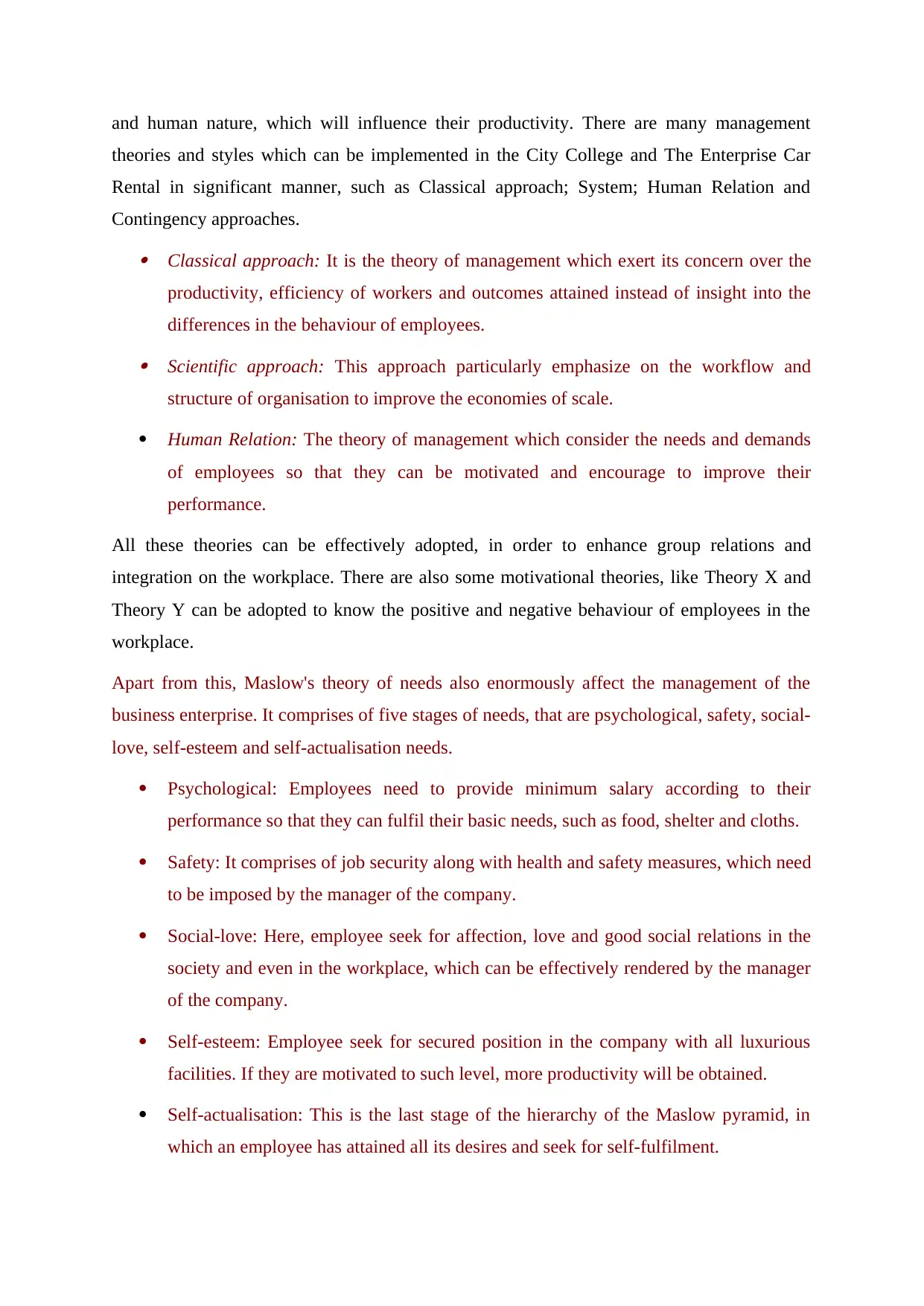
and human nature, which will influence their productivity. There are many management
theories and styles which can be implemented in the City College and The Enterprise Car
Rental in significant manner, such as Classical approach; System; Human Relation and
Contingency approaches. Classical approach: It is the theory of management which exert its concern over the
productivity, efficiency of workers and outcomes attained instead of insight into the
differences in the behaviour of employees. Scientific approach: This approach particularly emphasize on the workflow and
structure of organisation to improve the economies of scale.
Human Relation: The theory of management which consider the needs and demands
of employees so that they can be motivated and encourage to improve their
performance.
All these theories can be effectively adopted, in order to enhance group relations and
integration on the workplace. There are also some motivational theories, like Theory X and
Theory Y can be adopted to know the positive and negative behaviour of employees in the
workplace.
Apart from this, Maslow's theory of needs also enormously affect the management of the
business enterprise. It comprises of five stages of needs, that are psychological, safety, social-
love, self-esteem and self-actualisation needs.
Psychological: Employees need to provide minimum salary according to their
performance so that they can fulfil their basic needs, such as food, shelter and cloths.
Safety: It comprises of job security along with health and safety measures, which need
to be imposed by the manager of the company.
Social-love: Here, employee seek for affection, love and good social relations in the
society and even in the workplace, which can be effectively rendered by the manager
of the company.
Self-esteem: Employee seek for secured position in the company with all luxurious
facilities. If they are motivated to such level, more productivity will be obtained.
Self-actualisation: This is the last stage of the hierarchy of the Maslow pyramid, in
which an employee has attained all its desires and seek for self-fulfilment.
theories and styles which can be implemented in the City College and The Enterprise Car
Rental in significant manner, such as Classical approach; System; Human Relation and
Contingency approaches. Classical approach: It is the theory of management which exert its concern over the
productivity, efficiency of workers and outcomes attained instead of insight into the
differences in the behaviour of employees. Scientific approach: This approach particularly emphasize on the workflow and
structure of organisation to improve the economies of scale.
Human Relation: The theory of management which consider the needs and demands
of employees so that they can be motivated and encourage to improve their
performance.
All these theories can be effectively adopted, in order to enhance group relations and
integration on the workplace. There are also some motivational theories, like Theory X and
Theory Y can be adopted to know the positive and negative behaviour of employees in the
workplace.
Apart from this, Maslow's theory of needs also enormously affect the management of the
business enterprise. It comprises of five stages of needs, that are psychological, safety, social-
love, self-esteem and self-actualisation needs.
Psychological: Employees need to provide minimum salary according to their
performance so that they can fulfil their basic needs, such as food, shelter and cloths.
Safety: It comprises of job security along with health and safety measures, which need
to be imposed by the manager of the company.
Social-love: Here, employee seek for affection, love and good social relations in the
society and even in the workplace, which can be effectively rendered by the manager
of the company.
Self-esteem: Employee seek for secured position in the company with all luxurious
facilities. If they are motivated to such level, more productivity will be obtained.
Self-actualisation: This is the last stage of the hierarchy of the Maslow pyramid, in
which an employee has attained all its desires and seek for self-fulfilment.
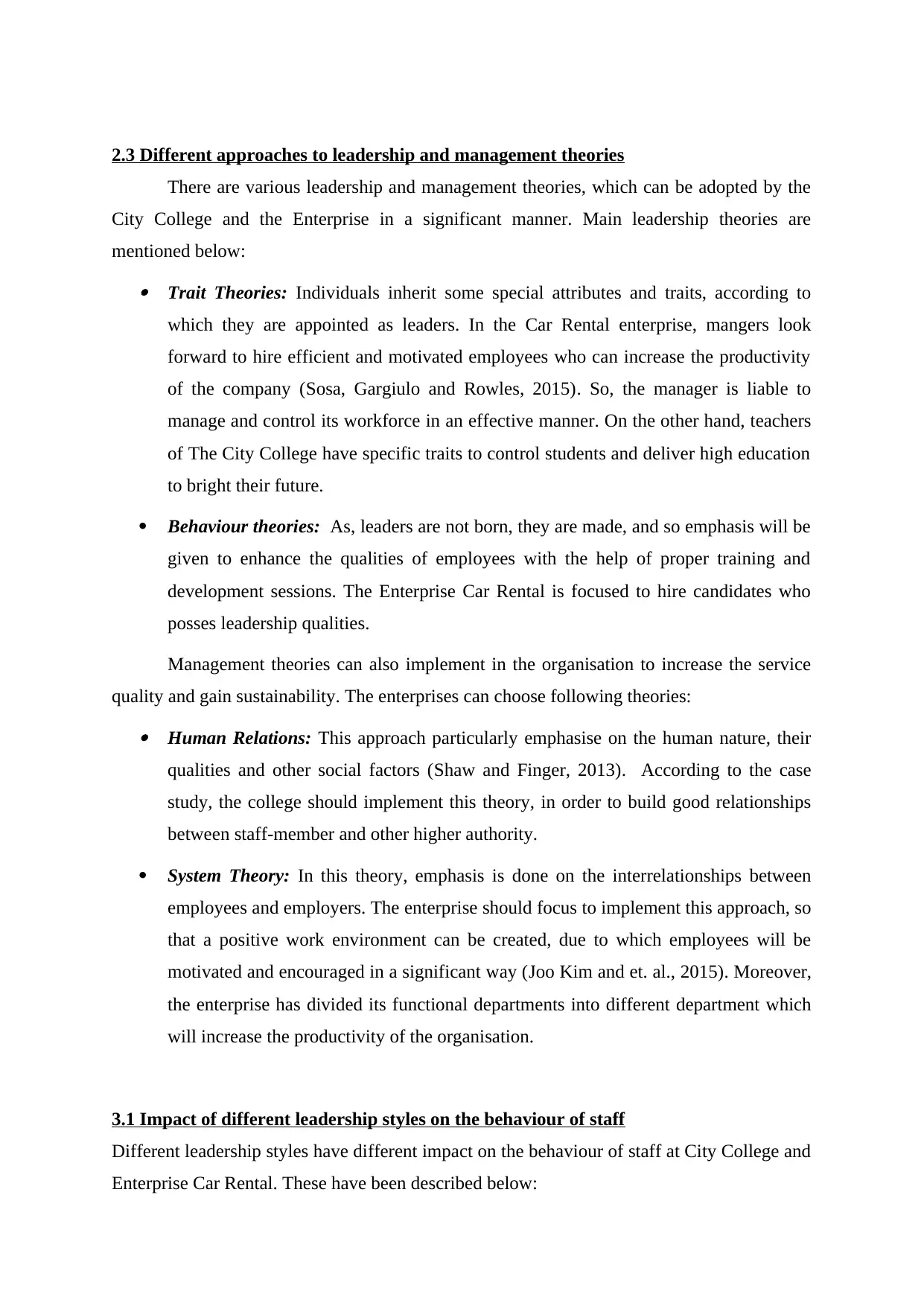
2.3 Different approaches to leadership and management theories
There are various leadership and management theories, which can be adopted by the
City College and the Enterprise in a significant manner. Main leadership theories are
mentioned below: Trait Theories: Individuals inherit some special attributes and traits, according to
which they are appointed as leaders. In the Car Rental enterprise, mangers look
forward to hire efficient and motivated employees who can increase the productivity
of the company (Sosa, Gargiulo and Rowles, 2015). So, the manager is liable to
manage and control its workforce in an effective manner. On the other hand, teachers
of The City College have specific traits to control students and deliver high education
to bright their future.
Behaviour theories: As, leaders are not born, they are made, and so emphasis will be
given to enhance the qualities of employees with the help of proper training and
development sessions. The Enterprise Car Rental is focused to hire candidates who
posses leadership qualities.
Management theories can also implement in the organisation to increase the service
quality and gain sustainability. The enterprises can choose following theories: Human Relations: This approach particularly emphasise on the human nature, their
qualities and other social factors (Shaw and Finger, 2013). According to the case
study, the college should implement this theory, in order to build good relationships
between staff-member and other higher authority.
System Theory: In this theory, emphasis is done on the interrelationships between
employees and employers. The enterprise should focus to implement this approach, so
that a positive work environment can be created, due to which employees will be
motivated and encouraged in a significant way (Joo Kim and et. al., 2015). Moreover,
the enterprise has divided its functional departments into different department which
will increase the productivity of the organisation.
3.1 Impact of different leadership styles on the behaviour of staff
Different leadership styles have different impact on the behaviour of staff at City College and
Enterprise Car Rental. These have been described below:
There are various leadership and management theories, which can be adopted by the
City College and the Enterprise in a significant manner. Main leadership theories are
mentioned below: Trait Theories: Individuals inherit some special attributes and traits, according to
which they are appointed as leaders. In the Car Rental enterprise, mangers look
forward to hire efficient and motivated employees who can increase the productivity
of the company (Sosa, Gargiulo and Rowles, 2015). So, the manager is liable to
manage and control its workforce in an effective manner. On the other hand, teachers
of The City College have specific traits to control students and deliver high education
to bright their future.
Behaviour theories: As, leaders are not born, they are made, and so emphasis will be
given to enhance the qualities of employees with the help of proper training and
development sessions. The Enterprise Car Rental is focused to hire candidates who
posses leadership qualities.
Management theories can also implement in the organisation to increase the service
quality and gain sustainability. The enterprises can choose following theories: Human Relations: This approach particularly emphasise on the human nature, their
qualities and other social factors (Shaw and Finger, 2013). According to the case
study, the college should implement this theory, in order to build good relationships
between staff-member and other higher authority.
System Theory: In this theory, emphasis is done on the interrelationships between
employees and employers. The enterprise should focus to implement this approach, so
that a positive work environment can be created, due to which employees will be
motivated and encouraged in a significant way (Joo Kim and et. al., 2015). Moreover,
the enterprise has divided its functional departments into different department which
will increase the productivity of the organisation.
3.1 Impact of different leadership styles on the behaviour of staff
Different leadership styles have different impact on the behaviour of staff at City College and
Enterprise Car Rental. These have been described below:
Secure Best Marks with AI Grader
Need help grading? Try our AI Grader for instant feedback on your assignments.
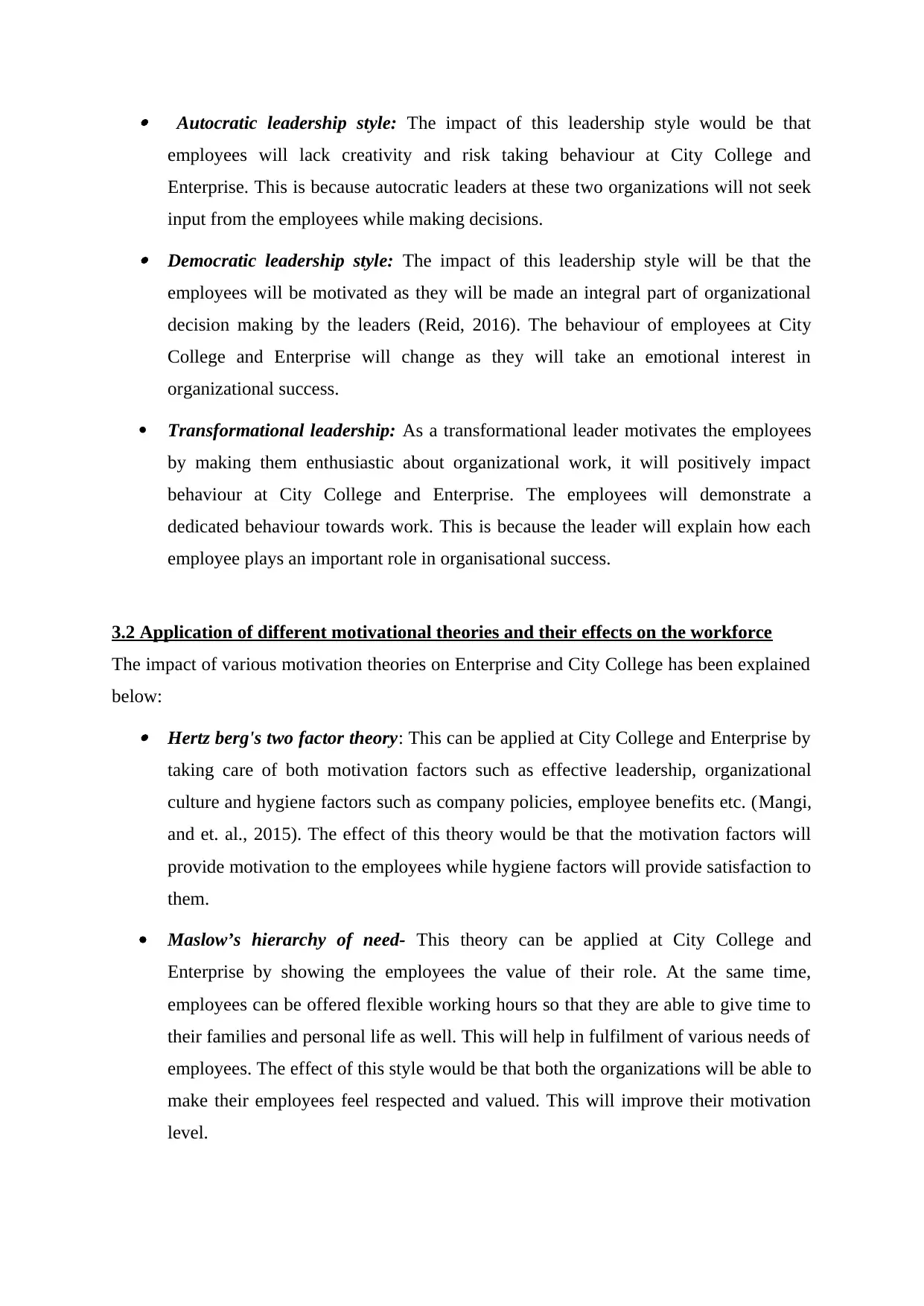
Autocratic leadership style: The impact of this leadership style would be that
employees will lack creativity and risk taking behaviour at City College and
Enterprise. This is because autocratic leaders at these two organizations will not seek
input from the employees while making decisions. Democratic leadership style: The impact of this leadership style will be that the
employees will be motivated as they will be made an integral part of organizational
decision making by the leaders (Reid, 2016). The behaviour of employees at City
College and Enterprise will change as they will take an emotional interest in
organizational success.
Transformational leadership: As a transformational leader motivates the employees
by making them enthusiastic about organizational work, it will positively impact
behaviour at City College and Enterprise. The employees will demonstrate a
dedicated behaviour towards work. This is because the leader will explain how each
employee plays an important role in organisational success.
3.2 Application of different motivational theories and their effects on the workforce
The impact of various motivation theories on Enterprise and City College has been explained
below: Hertz berg's two factor theory: This can be applied at City College and Enterprise by
taking care of both motivation factors such as effective leadership, organizational
culture and hygiene factors such as company policies, employee benefits etc. (Mangi,
and et. al., 2015). The effect of this theory would be that the motivation factors will
provide motivation to the employees while hygiene factors will provide satisfaction to
them.
Maslow’s hierarchy of need- This theory can be applied at City College and
Enterprise by showing the employees the value of their role. At the same time,
employees can be offered flexible working hours so that they are able to give time to
their families and personal life as well. This will help in fulfilment of various needs of
employees. The effect of this style would be that both the organizations will be able to
make their employees feel respected and valued. This will improve their motivation
level.
employees will lack creativity and risk taking behaviour at City College and
Enterprise. This is because autocratic leaders at these two organizations will not seek
input from the employees while making decisions. Democratic leadership style: The impact of this leadership style will be that the
employees will be motivated as they will be made an integral part of organizational
decision making by the leaders (Reid, 2016). The behaviour of employees at City
College and Enterprise will change as they will take an emotional interest in
organizational success.
Transformational leadership: As a transformational leader motivates the employees
by making them enthusiastic about organizational work, it will positively impact
behaviour at City College and Enterprise. The employees will demonstrate a
dedicated behaviour towards work. This is because the leader will explain how each
employee plays an important role in organisational success.
3.2 Application of different motivational theories and their effects on the workforce
The impact of various motivation theories on Enterprise and City College has been explained
below: Hertz berg's two factor theory: This can be applied at City College and Enterprise by
taking care of both motivation factors such as effective leadership, organizational
culture and hygiene factors such as company policies, employee benefits etc. (Mangi,
and et. al., 2015). The effect of this theory would be that the motivation factors will
provide motivation to the employees while hygiene factors will provide satisfaction to
them.
Maslow’s hierarchy of need- This theory can be applied at City College and
Enterprise by showing the employees the value of their role. At the same time,
employees can be offered flexible working hours so that they are able to give time to
their families and personal life as well. This will help in fulfilment of various needs of
employees. The effect of this style would be that both the organizations will be able to
make their employees feel respected and valued. This will improve their motivation
level.
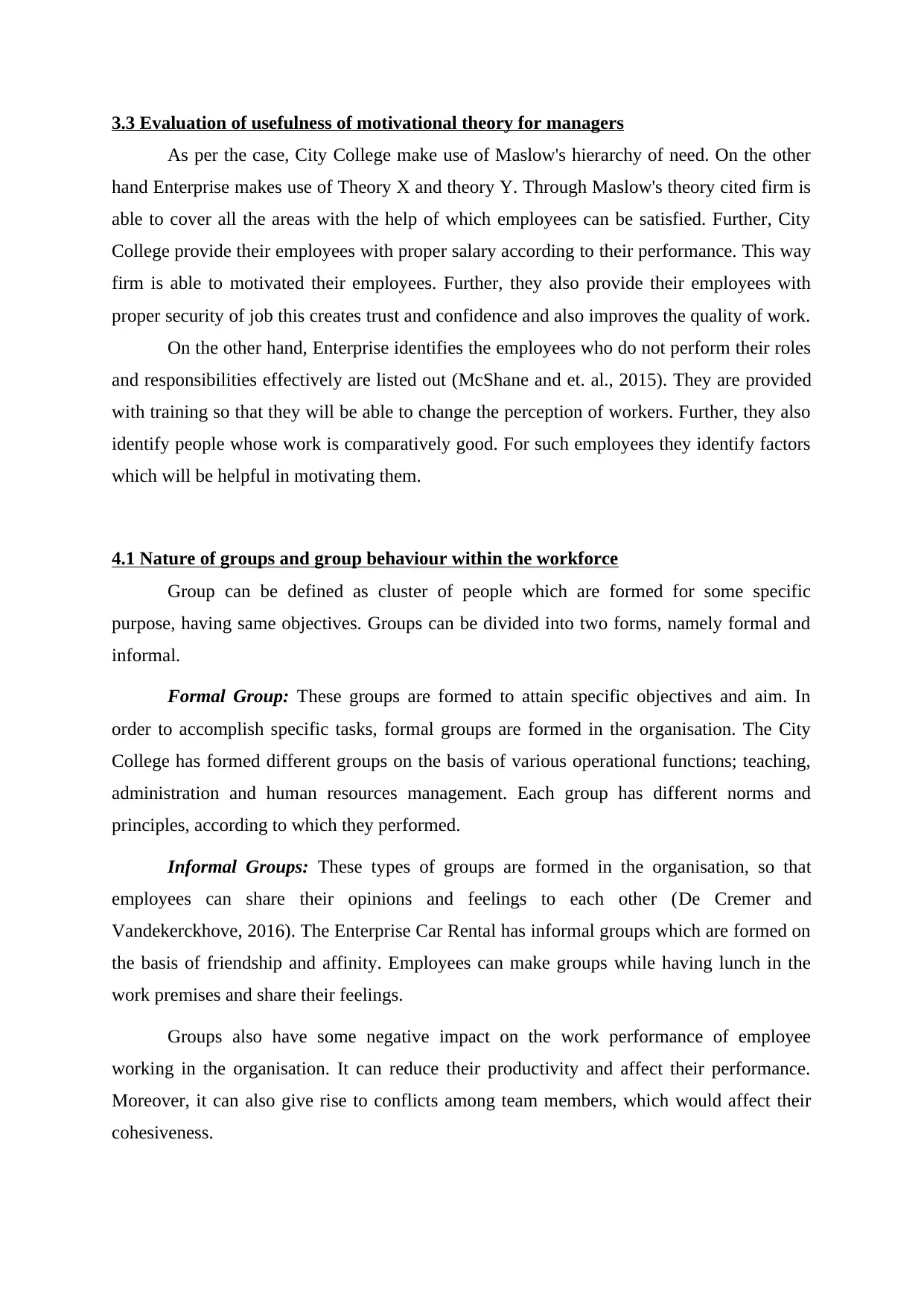
3.3 Evaluation of usefulness of motivational theory for managers
As per the case, City College make use of Maslow's hierarchy of need. On the other
hand Enterprise makes use of Theory X and theory Y. Through Maslow's theory cited firm is
able to cover all the areas with the help of which employees can be satisfied. Further, City
College provide their employees with proper salary according to their performance. This way
firm is able to motivated their employees. Further, they also provide their employees with
proper security of job this creates trust and confidence and also improves the quality of work.
On the other hand, Enterprise identifies the employees who do not perform their roles
and responsibilities effectively are listed out (McShane and et. al., 2015). They are provided
with training so that they will be able to change the perception of workers. Further, they also
identify people whose work is comparatively good. For such employees they identify factors
which will be helpful in motivating them.
4.1 Nature of groups and group behaviour within the workforce
Group can be defined as cluster of people which are formed for some specific
purpose, having same objectives. Groups can be divided into two forms, namely formal and
informal.
Formal Group: These groups are formed to attain specific objectives and aim. In
order to accomplish specific tasks, formal groups are formed in the organisation. The City
College has formed different groups on the basis of various operational functions; teaching,
administration and human resources management. Each group has different norms and
principles, according to which they performed.
Informal Groups: These types of groups are formed in the organisation, so that
employees can share their opinions and feelings to each other (De Cremer and
Vandekerckhove, 2016). The Enterprise Car Rental has informal groups which are formed on
the basis of friendship and affinity. Employees can make groups while having lunch in the
work premises and share their feelings.
Groups also have some negative impact on the work performance of employee
working in the organisation. It can reduce their productivity and affect their performance.
Moreover, it can also give rise to conflicts among team members, which would affect their
cohesiveness.
As per the case, City College make use of Maslow's hierarchy of need. On the other
hand Enterprise makes use of Theory X and theory Y. Through Maslow's theory cited firm is
able to cover all the areas with the help of which employees can be satisfied. Further, City
College provide their employees with proper salary according to their performance. This way
firm is able to motivated their employees. Further, they also provide their employees with
proper security of job this creates trust and confidence and also improves the quality of work.
On the other hand, Enterprise identifies the employees who do not perform their roles
and responsibilities effectively are listed out (McShane and et. al., 2015). They are provided
with training so that they will be able to change the perception of workers. Further, they also
identify people whose work is comparatively good. For such employees they identify factors
which will be helpful in motivating them.
4.1 Nature of groups and group behaviour within the workforce
Group can be defined as cluster of people which are formed for some specific
purpose, having same objectives. Groups can be divided into two forms, namely formal and
informal.
Formal Group: These groups are formed to attain specific objectives and aim. In
order to accomplish specific tasks, formal groups are formed in the organisation. The City
College has formed different groups on the basis of various operational functions; teaching,
administration and human resources management. Each group has different norms and
principles, according to which they performed.
Informal Groups: These types of groups are formed in the organisation, so that
employees can share their opinions and feelings to each other (De Cremer and
Vandekerckhove, 2016). The Enterprise Car Rental has informal groups which are formed on
the basis of friendship and affinity. Employees can make groups while having lunch in the
work premises and share their feelings.
Groups also have some negative impact on the work performance of employee
working in the organisation. It can reduce their productivity and affect their performance.
Moreover, it can also give rise to conflicts among team members, which would affect their
cohesiveness.
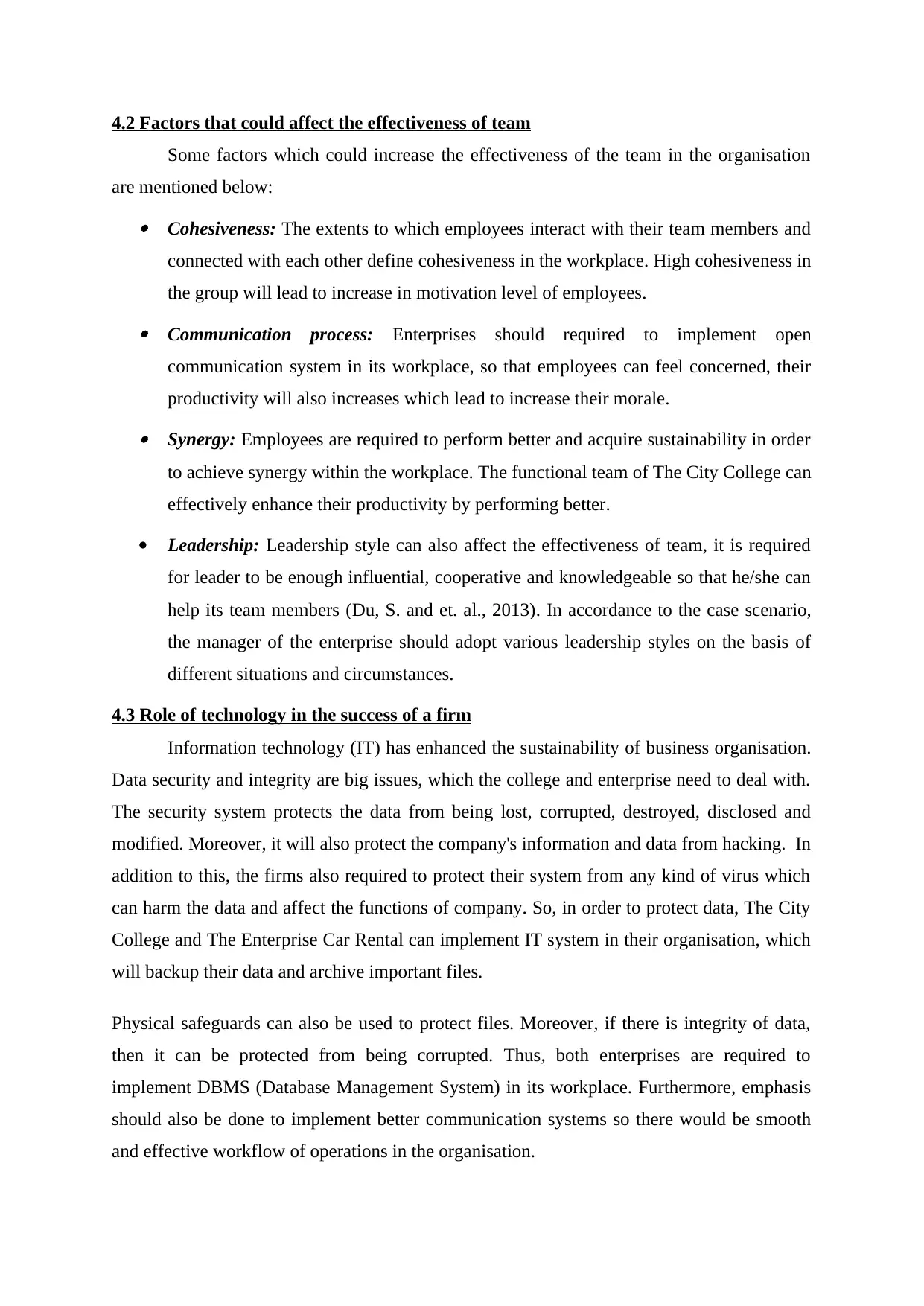
4.2 Factors that could affect the effectiveness of team
Some factors which could increase the effectiveness of the team in the organisation
are mentioned below: Cohesiveness: The extents to which employees interact with their team members and
connected with each other define cohesiveness in the workplace. High cohesiveness in
the group will lead to increase in motivation level of employees. Communication process: Enterprises should required to implement open
communication system in its workplace, so that employees can feel concerned, their
productivity will also increases which lead to increase their morale. Synergy: Employees are required to perform better and acquire sustainability in order
to achieve synergy within the workplace. The functional team of The City College can
effectively enhance their productivity by performing better.
Leadership: Leadership style can also affect the effectiveness of team, it is required
for leader to be enough influential, cooperative and knowledgeable so that he/she can
help its team members (Du, S. and et. al., 2013). In accordance to the case scenario,
the manager of the enterprise should adopt various leadership styles on the basis of
different situations and circumstances.
4.3 Role of technology in the success of a firm
Information technology (IT) has enhanced the sustainability of business organisation.
Data security and integrity are big issues, which the college and enterprise need to deal with.
The security system protects the data from being lost, corrupted, destroyed, disclosed and
modified. Moreover, it will also protect the company's information and data from hacking. In
addition to this, the firms also required to protect their system from any kind of virus which
can harm the data and affect the functions of company. So, in order to protect data, The City
College and The Enterprise Car Rental can implement IT system in their organisation, which
will backup their data and archive important files.
Physical safeguards can also be used to protect files. Moreover, if there is integrity of data,
then it can be protected from being corrupted. Thus, both enterprises are required to
implement DBMS (Database Management System) in its workplace. Furthermore, emphasis
should also be done to implement better communication systems so there would be smooth
and effective workflow of operations in the organisation.
Some factors which could increase the effectiveness of the team in the organisation
are mentioned below: Cohesiveness: The extents to which employees interact with their team members and
connected with each other define cohesiveness in the workplace. High cohesiveness in
the group will lead to increase in motivation level of employees. Communication process: Enterprises should required to implement open
communication system in its workplace, so that employees can feel concerned, their
productivity will also increases which lead to increase their morale. Synergy: Employees are required to perform better and acquire sustainability in order
to achieve synergy within the workplace. The functional team of The City College can
effectively enhance their productivity by performing better.
Leadership: Leadership style can also affect the effectiveness of team, it is required
for leader to be enough influential, cooperative and knowledgeable so that he/she can
help its team members (Du, S. and et. al., 2013). In accordance to the case scenario,
the manager of the enterprise should adopt various leadership styles on the basis of
different situations and circumstances.
4.3 Role of technology in the success of a firm
Information technology (IT) has enhanced the sustainability of business organisation.
Data security and integrity are big issues, which the college and enterprise need to deal with.
The security system protects the data from being lost, corrupted, destroyed, disclosed and
modified. Moreover, it will also protect the company's information and data from hacking. In
addition to this, the firms also required to protect their system from any kind of virus which
can harm the data and affect the functions of company. So, in order to protect data, The City
College and The Enterprise Car Rental can implement IT system in their organisation, which
will backup their data and archive important files.
Physical safeguards can also be used to protect files. Moreover, if there is integrity of data,
then it can be protected from being corrupted. Thus, both enterprises are required to
implement DBMS (Database Management System) in its workplace. Furthermore, emphasis
should also be done to implement better communication systems so there would be smooth
and effective workflow of operations in the organisation.
Paraphrase This Document
Need a fresh take? Get an instant paraphrase of this document with our AI Paraphraser
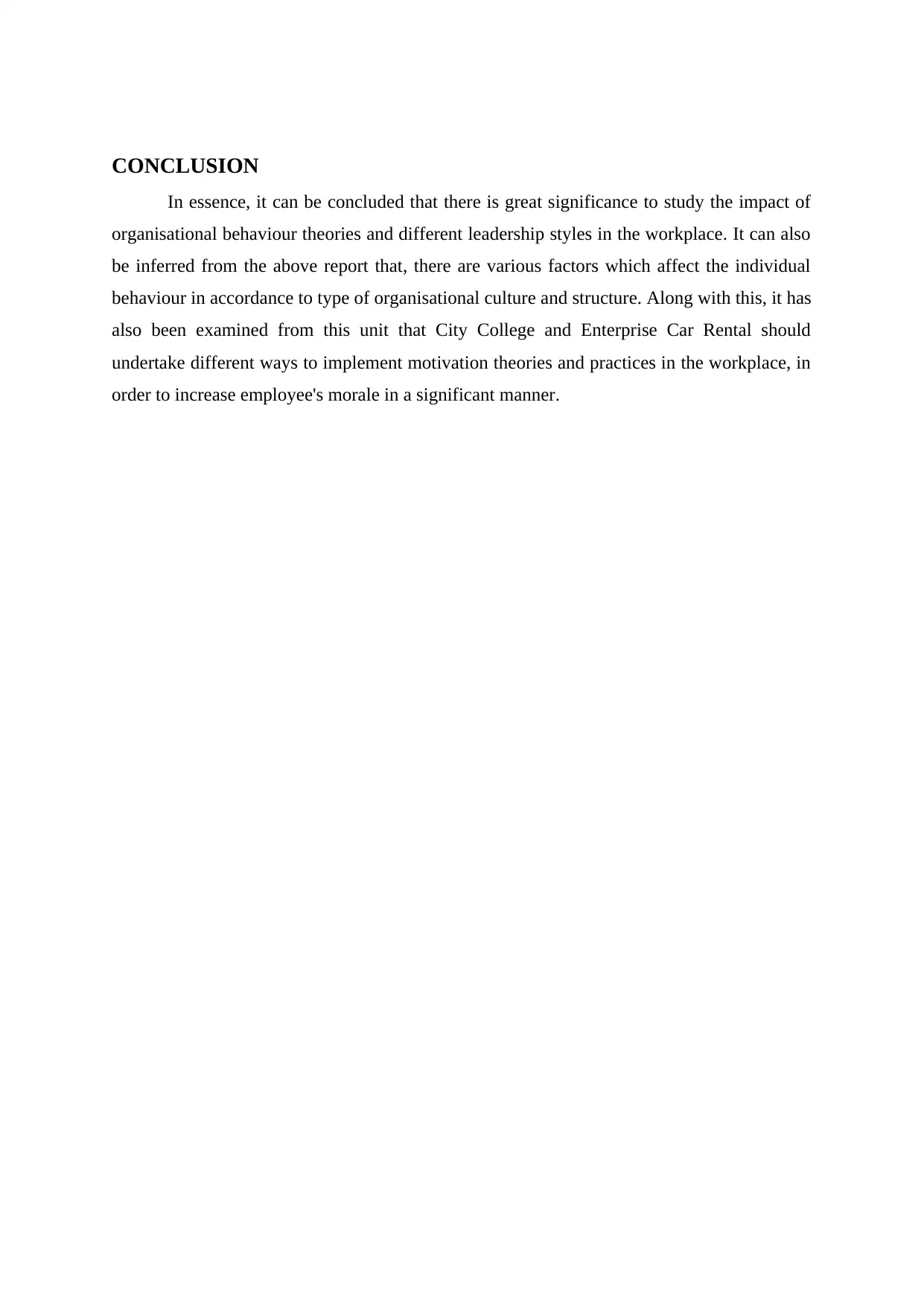
CONCLUSION
In essence, it can be concluded that there is great significance to study the impact of
organisational behaviour theories and different leadership styles in the workplace. It can also
be inferred from the above report that, there are various factors which affect the individual
behaviour in accordance to type of organisational culture and structure. Along with this, it has
also been examined from this unit that City College and Enterprise Car Rental should
undertake different ways to implement motivation theories and practices in the workplace, in
order to increase employee's morale in a significant manner.
In essence, it can be concluded that there is great significance to study the impact of
organisational behaviour theories and different leadership styles in the workplace. It can also
be inferred from the above report that, there are various factors which affect the individual
behaviour in accordance to type of organisational culture and structure. Along with this, it has
also been examined from this unit that City College and Enterprise Car Rental should
undertake different ways to implement motivation theories and practices in the workplace, in
order to increase employee's morale in a significant manner.
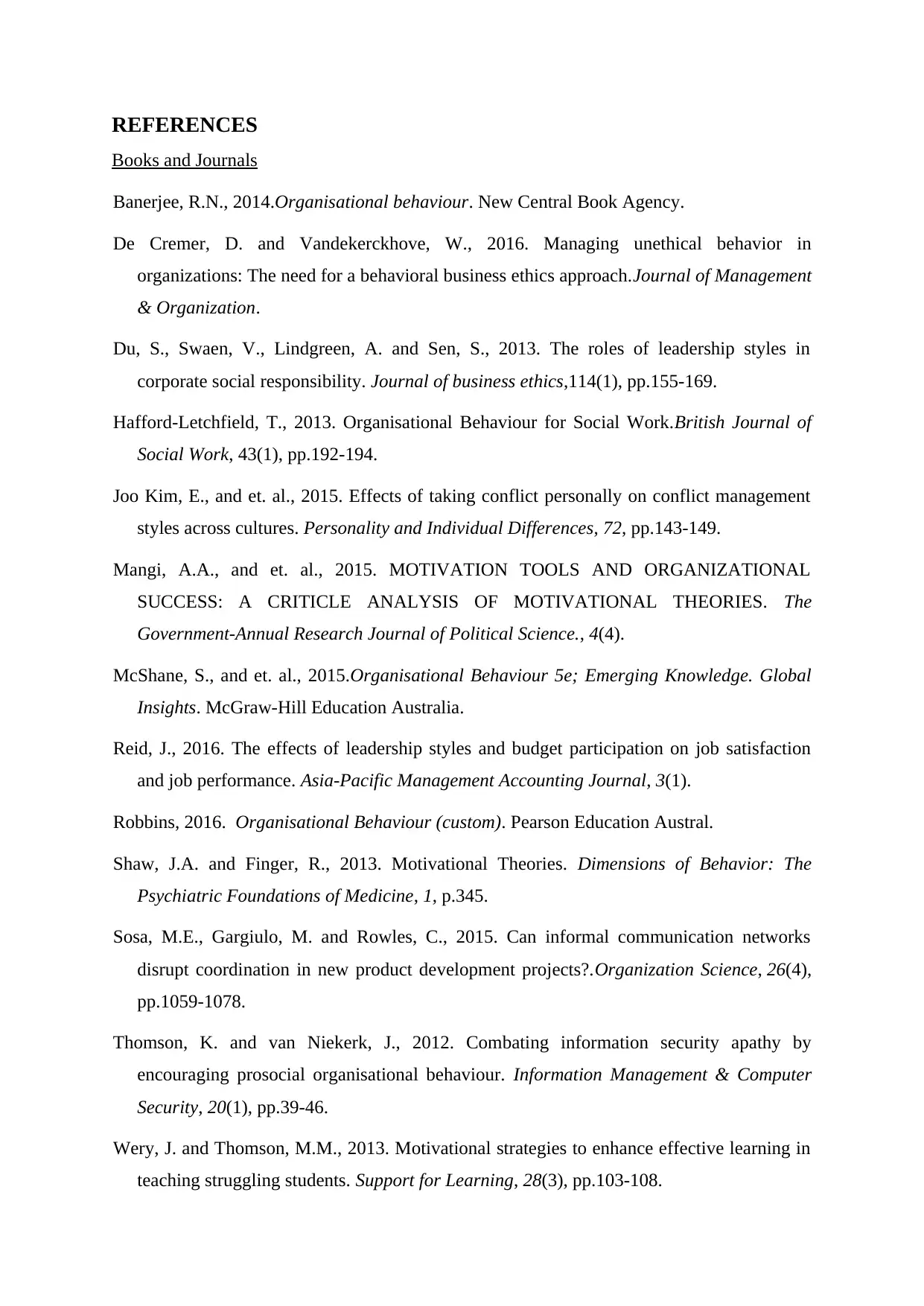
REFERENCES
Books and Journals
Banerjee, R.N., 2014.Organisational behaviour. New Central Book Agency.
De Cremer, D. and Vandekerckhove, W., 2016. Managing unethical behavior in
organizations: The need for a behavioral business ethics approach.Journal of Management
& Organization.
Du, S., Swaen, V., Lindgreen, A. and Sen, S., 2013. The roles of leadership styles in
corporate social responsibility. Journal of business ethics,114(1), pp.155-169.
Hafford-Letchfield, T., 2013. Organisational Behaviour for Social Work.British Journal of
Social Work, 43(1), pp.192-194.
Joo Kim, E., and et. al., 2015. Effects of taking conflict personally on conflict management
styles across cultures. Personality and Individual Differences, 72, pp.143-149.
Mangi, A.A., and et. al., 2015. MOTIVATION TOOLS AND ORGANIZATIONAL
SUCCESS: A CRITICLE ANALYSIS OF MOTIVATIONAL THEORIES. The
Government-Annual Research Journal of Political Science., 4(4).
McShane, S., and et. al., 2015.Organisational Behaviour 5e; Emerging Knowledge. Global
Insights. McGraw-Hill Education Australia.
Reid, J., 2016. The effects of leadership styles and budget participation on job satisfaction
and job performance. Asia-Pacific Management Accounting Journal, 3(1).
Robbins, 2016. Organisational Behaviour (custom). Pearson Education Austral.
Shaw, J.A. and Finger, R., 2013. Motivational Theories. Dimensions of Behavior: The
Psychiatric Foundations of Medicine, 1, p.345.
Sosa, M.E., Gargiulo, M. and Rowles, C., 2015. Can informal communication networks
disrupt coordination in new product development projects?.Organization Science, 26(4),
pp.1059-1078.
Thomson, K. and van Niekerk, J., 2012. Combating information security apathy by
encouraging prosocial organisational behaviour. Information Management & Computer
Security, 20(1), pp.39-46.
Wery, J. and Thomson, M.M., 2013. Motivational strategies to enhance effective learning in
teaching struggling students. Support for Learning, 28(3), pp.103-108.
Books and Journals
Banerjee, R.N., 2014.Organisational behaviour. New Central Book Agency.
De Cremer, D. and Vandekerckhove, W., 2016. Managing unethical behavior in
organizations: The need for a behavioral business ethics approach.Journal of Management
& Organization.
Du, S., Swaen, V., Lindgreen, A. and Sen, S., 2013. The roles of leadership styles in
corporate social responsibility. Journal of business ethics,114(1), pp.155-169.
Hafford-Letchfield, T., 2013. Organisational Behaviour for Social Work.British Journal of
Social Work, 43(1), pp.192-194.
Joo Kim, E., and et. al., 2015. Effects of taking conflict personally on conflict management
styles across cultures. Personality and Individual Differences, 72, pp.143-149.
Mangi, A.A., and et. al., 2015. MOTIVATION TOOLS AND ORGANIZATIONAL
SUCCESS: A CRITICLE ANALYSIS OF MOTIVATIONAL THEORIES. The
Government-Annual Research Journal of Political Science., 4(4).
McShane, S., and et. al., 2015.Organisational Behaviour 5e; Emerging Knowledge. Global
Insights. McGraw-Hill Education Australia.
Reid, J., 2016. The effects of leadership styles and budget participation on job satisfaction
and job performance. Asia-Pacific Management Accounting Journal, 3(1).
Robbins, 2016. Organisational Behaviour (custom). Pearson Education Austral.
Shaw, J.A. and Finger, R., 2013. Motivational Theories. Dimensions of Behavior: The
Psychiatric Foundations of Medicine, 1, p.345.
Sosa, M.E., Gargiulo, M. and Rowles, C., 2015. Can informal communication networks
disrupt coordination in new product development projects?.Organization Science, 26(4),
pp.1059-1078.
Thomson, K. and van Niekerk, J., 2012. Combating information security apathy by
encouraging prosocial organisational behaviour. Information Management & Computer
Security, 20(1), pp.39-46.
Wery, J. and Thomson, M.M., 2013. Motivational strategies to enhance effective learning in
teaching struggling students. Support for Learning, 28(3), pp.103-108.
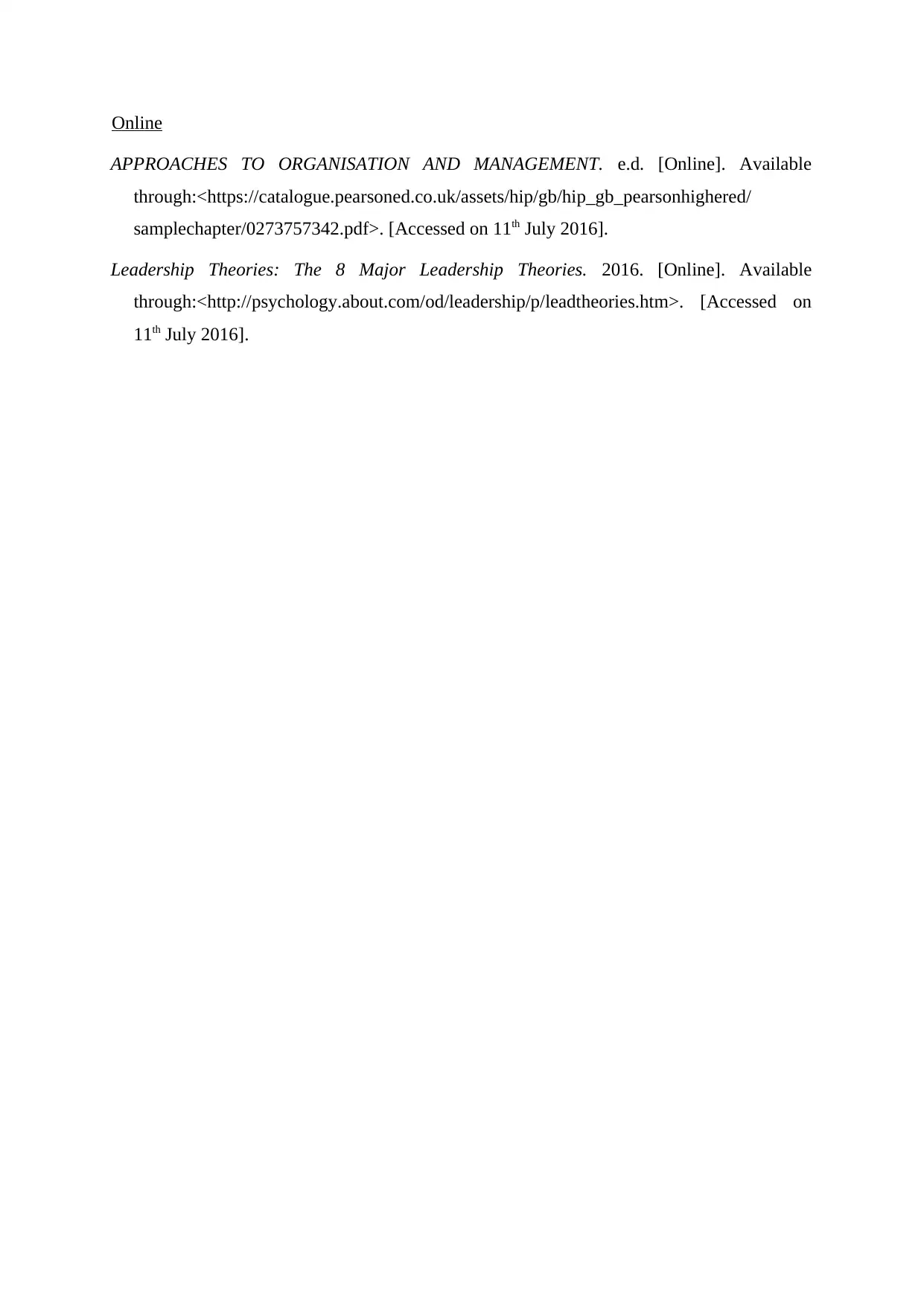
Online
APPROACHES TO ORGANISATION AND MANAGEMENT. e.d. [Online]. Available
through:<https://catalogue.pearsoned.co.uk/assets/hip/gb/hip_gb_pearsonhighered/
samplechapter/0273757342.pdf>. [Accessed on 11th July 2016].
Leadership Theories: The 8 Major Leadership Theories. 2016. [Online]. Available
through:<http://psychology.about.com/od/leadership/p/leadtheories.htm>. [Accessed on
11th July 2016].
APPROACHES TO ORGANISATION AND MANAGEMENT. e.d. [Online]. Available
through:<https://catalogue.pearsoned.co.uk/assets/hip/gb/hip_gb_pearsonhighered/
samplechapter/0273757342.pdf>. [Accessed on 11th July 2016].
Leadership Theories: The 8 Major Leadership Theories. 2016. [Online]. Available
through:<http://psychology.about.com/od/leadership/p/leadtheories.htm>. [Accessed on
11th July 2016].
1 out of 16
Related Documents
Your All-in-One AI-Powered Toolkit for Academic Success.
+13062052269
info@desklib.com
Available 24*7 on WhatsApp / Email
![[object Object]](/_next/static/media/star-bottom.7253800d.svg)
Unlock your academic potential
© 2024 | Zucol Services PVT LTD | All rights reserved.





